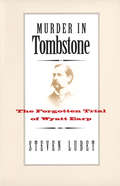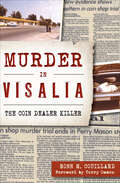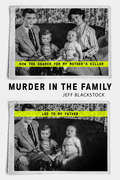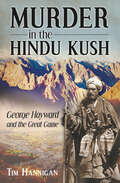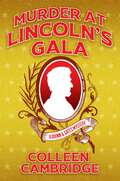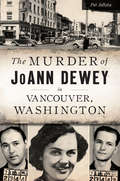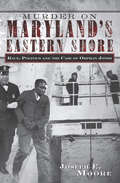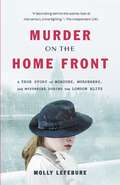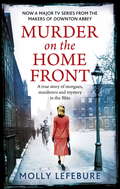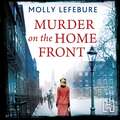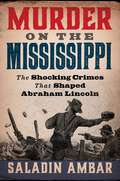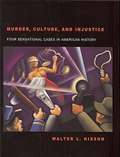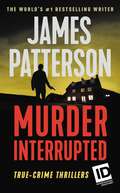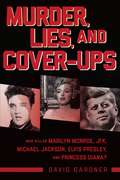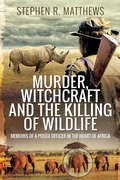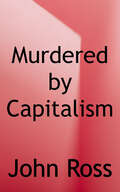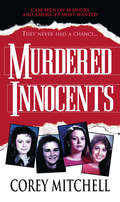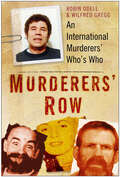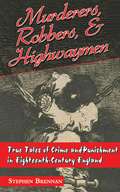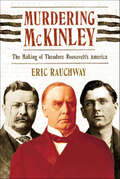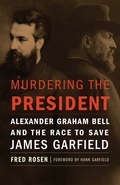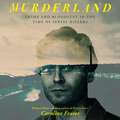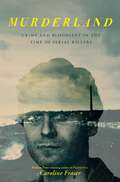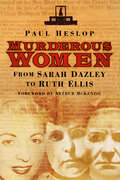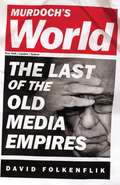- Table View
- List View
Murder in Tombstone: The Forgotten Trial of Wyatt Earp (The Lamar Series in Western History)
by Steven LubetThis account of the court case that followed the gunfight at the OK Corral &“will interest Wild West buffs as well as readers interested in legal history&” (Publishers Weekly). The gunfight at the OK Corral lasted less than a minute—yet it became the basis for countless stories about the Wild West. At the time of the event, however, Wyatt Earp was not universally acclaimed as a hero. Among the people who knew him best in Tombstone, Arizona, many considered him a renegade and murderer. This book tells the nearly unknown story of the prosecution of Wyatt Earp, his brothers, and Doc Holiday following the famous gunfight. To the prosecutors, the Earps and Holiday were wanton killers. According to the defense, the Earps were steadfast heroes—willing to risk their lives on the mean streets of Tombstone for the sake of order. The case against the Earps, with its dueling narratives of brutality and justification, played out themes of betrayal, revenge, and even adultery. Attorney Thomas Fitch, one of the era&’s finest advocates, ultimately managed, against considerable odds, to save Earp from the gallows. But the case could easily have ended in a conviction—and Wyatt Earp would have been hanged or imprisoned instead of celebrated as an American icon. &“This trial has everything: a family feud, famous outlaws and lawmen, politics, sex, and the most famous shootout in frontier history . . . Lubet&’s accessible and highly original book will set a standard for scholarship in a field laden with folklore.&” —Allen Barra, author of Inventing Wyatt Earp
Murder in Visalia: The Coin Dealer Killer (Murder And Mayhem Ser.)
by Ronn M. Couillard&“Recounts all the twists and turns of the case . . . two jury trials, a surprising appellate court ruling . . . and, decades later, a shocking development&” (Visalia Times Delta). One October morning in 1979, a stamp and coin dealer was gunned down in his Visalia shop. There were no witnesses. Persistent police efforts across jurisdictional lines connected it to another death. Two months earlier, the body of a Fresno coin dealer was found locked in the trunk of his car. The trail of evidence led to a most unlikely suspect. Author Ronn M. Couillard, retired judge and former Visalia district attorney, lays out the facts in this compelling case from the investigation to the court proceedings and the surprise that almost derailed the conviction. Includes photos!
Murder in the Family: How the Search for My Mother's Killer Led to My Father
by Jeff BlackstockDiplomat father. Murdered mother. Emotionally neglected children. An apparent cover-up. Family dinners will never be the same."I think that my father murdered my mother." That terrible belief spurs author Jeff Blackstock to investigate the circumstances of his mother Carol's death when he was a child. Carol Blackstock died at age 24 in 1959--poisoned by arsenic--but the cause of her death remained shrouded in mystery for decades. Jeff's father George Blackstock was a career diplomat in Canada's foreign service, posted to glamorous Buenos Aires with his wife Carol and their three children. A little more than a year after the family's arrival, the vivacious young mother, now emaciated and in terrible pain, was transferred to Montreal for treatment of a mysterious illness that proved fatal. In the following year, George Blackstock remarried, and a young woman named Ingrid became the feared stepmother to Jeff and his two siblings. Carol's parents soon had suspicions about their son-in-law George but were unable to get justice for their daughter. Class privilege--George was the scion of a Toronto establishment family and Carol was from modest beginnings--and an aversion to scandal all figured in an apparent cover-up. But secrets have a way of eventually disrupting all families. A damning autopsy report about arsenic poisoning, found among their grandmother's effects, leads Jeff Blackstock and his sister to horrifying revelations about their father. Eventually, they confront him and accuse him of their mother's murder. But George offers only vague explanations that don't add up. George died a broken man, mostly abandoned by his adult children.A compelling story of a high-society murder, a heartbreaking tale of emotionally neglected children, and an inquiry into the power and privilege of the Anglo upper classes of the time, Murder in the Family chronicles the shocking legacy of deeply buried secrets and betrayal in one's own family.
Murder in the Hindu Kush: George Hayward and the Great Game
by Tim HanniganOn a bright July morning in 1870 the British explorer George Hayward was brutally murdered high in the Hindu Kush. Who was he, what had brought him to this wild spot, and why was he killed? Told in full for the first time, this is the gripping tale of Hayward's journey from a Yorkshire childhood to a place at the forefront of the 'Great Game' between the British Raj and the Russian Empire, and of how, driven by 'an insane desire', he crossed the Western Himalayas, tangled with despotic chieftains and ended up on the wrong side of both the Raj and the mighty Maharaja of Kashmir. It is also the tale of the conspiracies that surrounded his death, while the author's own travels in Hayward's footsteps bring the story up to date, and reveal how the echoes of the Great Game still reverberate across Central Asiain the twenty-first century.
Murder in the Lincoln White House (Lincoln's White House Mystery #1)
by C. M. GleasonFrom the bestselling author of the American in Paris mysteries featuring Julia Child&’s best friend, and the Phyllida Bright mysteries featuring Agatha Christie&’s fictional housekeeper, this intriguing mystery stars quick-witted Adam Quinn, President Lincoln&’s newly hired aide, on a momentous day . . .March 4, 1861: On the day of Abraham Lincoln&’s inauguration gala, the last thing anyone wants is a hitch in the proceedings—let alone murder. But when the worst happens, fortunately, Mr. Lincoln has his resourceful aide by his side . . . When a man is found stabbed to death only yards from the new president, Lincoln dispatches his trusted aide Adam Quinn to discreetly investigate. Was it an assassination attempt gone wrong or some other sinister motive? Though he is new to the capital city, Quinn, an experienced tracker and seasoned soldier, is well-suited to the task. Though he must navigate the unfamiliar world of high society, political personages, and a city preparing for war, he finds an unexpected ally in determined young Sophie Gates, who lives in the Smithsonian Institution with her uncle and his family. Sophie is determined to make a name for herself as a journalist, and investigating a murder at the gala is the perfect opportunity. Quinn and Gates, along with George Hilton, a free man of color and brilliant physician, plunge into a city teeming with spies and dark plots as it careens toward war. Together, they must make haste to apprehend a killer—for nothing less than the fate of the nation is at stake . . . Praise for the author&’s previous mysteries &“Exhilarating. . . . Sure to please.&” —The New York Times Sunday Book Review &“Wonderfully witty . . . deliciously dark and delightfully entertaining.&” —The Chicago Tribune&“Gleason&’s novel is a well-oiled machine . . . the authentic historical framework . . . the compelling personalities.&” —School Library Journal
Murder of JoAnn Dewey in Vancouver, Washington, The (True Crime)
by Pat JollotaBefore midnight on March 19, 1950, several startled bystanders watched two men force a screaming young woman into a car and drive away from Saint Joseph's Hospital in Vancouver. One of them yelled out that she was his wife and was drunk. That was the last time anyone saw JoAnn Dewey alive. Her battered, naked body washed up on the banks of the Wind River seven days later. Suspicion quickly fell on two brothers, Turman and Utah Wilson, who fled town before police caught them in Sacramento. Their arrest and sensational trial captivated and divided the peaceful community. Author Pat Jollota uncovers the chilling details of this tragic story.
Murder on Maryland's Eastern Shore: Race, Politics and the Case of Orphan Jones (True Crime Ser.)
by Joseph E. MooreFrom a former Maryland attorney comes the true crime story of accused murderer Orphan Jones—a case mired in the racism and politics of 1930s America. Euel Lee, alias Orphan Jones, was an African American accused of murdering his white employer and family over a single dollar. The tumultuous events and cast of characters surrounding the racially charged crime garnered national media attention and changed the course of Maryland history. With exacting research, former Maryland State&’s Attorney Joseph E. Moore reconstructs the murders, the ensuing roller coast of a trial, and the eventual conviction and execution of Orphan Jones. Moore details all of this in the context of Jim Crow politics and American society during the Great Depression in this gripping true crime account. &“The Euel Lee case as explored by Joe Moore is more than good, readable, local history. It is about the stresses and strains in American society in the Depression, from the radicalism of a young Communist lawyer to the conscious efforts of a rural community to contain violence, confront or at least deal with their prejudices and see that justice was served for a senseless murder in their midst. Moore sets a high standard of factual accountability and entertaining narrative based upon oral history and archival research. General readers and scholars alike will not be disappointed.&” —Edward C. Papenfuse, PhD, Maryland State Archivist and Commissioner of Land Patents
Murder on the Home Front: A True Story of Morgues, Murderers, and Mysteries during the London Blitz
by Molly LefebureIt is 1941. While the "war of chaos" rages in the skies above London, an unending fight against violence, murder and the criminal underworld continues on the streets below.One ordinary day, in an ordinary courtroom, forensic pathologist Dr. Keith Simpson asks a keen young journalist to be his secretary. Although the "horrors of secretarial work" don't appeal to Molly Lefebure, she's intrigued to know exactly what goes on behind a mortuary door.Capable and curious, "Miss Molly" quickly becomes indispensible to Dr. Simpson as he meticulously pursues the truth. Accompanying him from somber morgues to London's most gruesome crime scenes, Molly observes and assists as he uncovers the dark secrets that all murder victims keep.With a sharp sense of humor and a rebellious spirit, Molly tells her own remarkable true story here with warmth and wit, painting a vivid portrait of wartime London.
Murder on the Home Front: a gripping murder mystery set during the Blitz - now on Netflix!
by Molly LefebureThe remarkable true story, as seen in the brilliant TV adaptation now showing on Netflix! Murder on the Home Front follows Molly Lefebure as she navigates working for the Home Office's chief forensic pathologist while living in a bomb-stricken London during the second world war. One ordinary day in 1941, forensic pathologist Dr Keith Simpson asks a keen young journalist to be his secretary. Although the 'horrors of secretarial work' don't appeal to Molly Lefebure, she's intrigued to find out exactly what goes on behind a mortuary door. Capable and curious, 'Miss Molly' quickly becomes indispensible to Dr Simpson as he meticulously pursues the truth. Accompanying him from sombre morgues to London's most gruesome crime scenes, Molly observes and assists the investigations into murders which, despite the war around them, are still being perpetrated.
Murder on the Home Front: a gripping murder mystery set during the Blitz - now on Netflix!
by Molly LefebureIt is 1941. There may be a 'war of chaos' in the skies over London, but 'the perpetual war against the underworld of crime' must nevertheless continue on the streets below. At 12 o'clock on a Spring day in a London Coroner's Court, famed forensic pathologist Dr Keith Simpson asks young journalist Molly Lefebure if she might like to become his secretary. Recalling the 'horror of secretarial work and secretarial young ladies', she turns him down flat, resolving to stick to twelve-hour days covering 'everything from Boy Scout meetings to the blitz'. By 3 o'clock that afternoon, curious about exactly what goes on behind a mortuary door, Molly has changed her mind. It is the beginning of an extraordinary adventure. 'Miss Molly' becomes Dr Simpson's right-hand woman, following him to crime scenes, courtrooms and mortuaries, taking notes, collecting evidence and witnessing the most shocking of sights. 'You'll never regret going to work in the mortuaries, Miss Molly,' a coroner's officer told her. 'There's never a dull moment with the bodies around.'
Murder on the Mississippi: The Shocking Crimes That Shaped Abraham Lincoln
by Saladin AmbarMurder, mob rule, and the making of Abraham Lincoln—the story of three racially motivated murders in Mississippi River towns from 1835 to 1838 that inspired the speech that put Lincoln on the national map—the Lyceum Address.Lynched: five white gamblers suspected of aiding a slave insurrection in Vicksburg, Mississippi. Burned Alive: a Black man implicated in the death of a constable in St. Louis, Missouri. Gunned Down: a white abolitionist in Alton, Illinois. These weren&’t just acts of mob violence—they were warnings of a nation on the edge of collapse. In Murder on the Mississippi, award-winning historian Saladin Ambar unearths the horrors that shaped a young Abraham Lincoln&’s worldview, pushing him to find his political voice in one of the earliest and most pivotal speeches of his career. Confronted by lawlessness, racial terror, and his own inner demons, Lincoln&’s battle was political and deeply personal. Amid the string of murders on the American frontier, Lincoln faced the loss of his first love—and a descent into suicidal despair. Yet from this darkness, he emerged with a renewed purpose, one that would define his leadership in the fight for democracy, human freedom, and the rule of law. From the flames of mob violence rose a young Lincoln, forged in fire and soon to contend with a nation at war with itself.
Murder, Culture, and Injustice: Four Sensational Cases in American History
by Walter L. HixsonPresents an account of four sensational national murder cases 'the Lizzie Borden murders, the Lindbergh baby case, the Sam Sheppard case, and the O J Simpson case'. This title offers observations into the greater cultural and political forces that shaped their verdicts, with step-by-step analysis of the details of each case.
Murder, Interrupted: True-crime Thrillers (James Patterson's Murder is Forever #1)
by James PattersonTwo true-crime thrillers as seen on Discovery's Murder is Forever TV series - premiering January 2018MURDER, INTERRUPTED. Rich, cheating financier Frank Howard wants his wife dead, and he's willing to pay Billie Earl Johnson whatever it takes, to the tune of $750,000. When his bullet misses the mark, Billie Earl and Frank will turn on each other in a fight for their lives . . . MOTHER OF ALL MURDERS. Dee Dee Blancharde is a local celebrity. Television reports praise her as a single mother who tirelessly cares for her wheelchair-bound, chronically ill daughter. But when the teenaged Gypsy Rose realizes she isn't actually sick and Dee Dee has lied all these years, Gypsy Rose exacts her revenge . . .
Murder, Lies, and Cover-Ups: Who Killed Marilyn Monroe, JFK, Michael Jackson, Elvis Presley, and Princess Diana?
by David GardnerUncover the real truth behind mass media accounts of how they died, and learn the reason for their murders. These five deaths stopped the whole world in its tracks. We all famously recall where we were and what we were doing when JFK was assassinated, as well as the moments Elvis, Princess Diana, and Michael Jackson died. As for Marilyn Monroe, the candle flickered out long ago, but only now can the truth be told about how—and why—she died. After combing through thousands of recently declassified FBI files and interviewing key witnesses, crime analysts, and forensic experts during years of research, investigative writer David Gardner has unearthed new information that will transform the way we look at these iconic tragedies that have long fascinated and intrigued the general public. Murder, Lies, and Cover-Ups reveals that Elvis Presley died not as a self-obsessed caricature but as a genuine hero who may have signed his death warrant going undercover for the FBI; how Marilyn Monroe's secret affairs with JFK and his brother, Robert, left her in the crosshairs of a lethal conspiracy; why Princess Diana's death was no accident; who ordered President John F. Kennedy's assassination; and how on three occasions Michael Jackson “died” of painkiller drug overdoses in the months before his death. In the wake of new evidence and testimonies, Murder, Lies, and Cover-Ups provides many of the answers that have been elusive for so long, while explaining what it was about these enduring legends that made their legacies burn so bright.
Murder, Witchcraft and the Killing of Wildlife: Memoirs of a Police Officer in the Heart of Africa
by Stephen R. MatthewsA former British police officer’s memoir of his assignment in Northern Rhodesia where he encountered black magic, cannibals, human trafficking, and more.Stephen R. Matthew’s first police posting near the Northern Rhodesian border with the Congo coincided dramatically with a time of horrific ethnic cleansing in the Belgian Congo area. At just twenty-one years old, Stephen was knifed, ambushed, stoned, shot, and wounded by bow and arrow. Steve’s life was saved several times by his courageous Doberman, Alex . . . This is the true, action-packed, unadulterated stories of those frantic and dangerous years, where a young police inspector confronted terrifying actions and events well beyond his complete understanding. He found that the cops were fighting on two fronts: trying to protect the vulnerable citizens of the country and at the same time endeavoring to stop the slaughter of wildlife.This unique book depicts dramatic accounts of witchcraft-murders and cannibalism. Highly dangerous solo investigations are detailed, incorporating incidents of black magic, kidnapping, arson, gun-running and people trafficking.“[A] rattling good memoir by a former British police officer writing of his colorful career while on assignment in Congo . . . . Despite his best attempts, Matthews could never shake off the way the locals saw him, as a white witch doctor with the ability to speak with the spirits of the dead and place spells against the living. There’s a story—several, in fact—about what led to this perception, which proves that, at the very least, the author learned a thing or two about telling a tale.” —The New York Times
Murdered By Capitalism: A Memoir of 150 Years of Life and Death on the American Left (Nation Bks.)
by John RossA San Francisco Chronicle Best Book of 2004 After spilling bourbon on Schnaubelt's grave, its pugnacious and very dead occupant becomes Ross's mentor, sidekick, and boozing companion through this epic telling of the hallucinatory, carnal, and ornery histories of the American Left and John Ross's own remarkable life. Schnaubelt navigates us through his seemingly boundless revolutionary battleground, uttering cries of subversion from within the grave while trying to remain out of earshot from the FBI snoop and local supermarket tycoon buried nearby. Ross's own story -- hobo revolutionist, junkie, poet, and journalist is a contrapuntal to Schnaubelt's. Ross never takes himself too seriously, yet his most remarkable trait is the honesty with which he approaches life, even while trying to deconstruct his own faults, personal tragedies (including the death of his one-month-old son), and imperfections. His pursuit of revolutionary politics and poetics is the constant, often spent with his muse, Revolutionary Mexico. Ross concludes with a trip to Baghdad as a "human shield," before the Anglo-American invasion, ready to sacrifice his life as part of his perpetual struggle for justice. Award-winning writer John Ross's memoir is inspired from a tumbledown tombstone in California: The headstone reads: E. B. Schnaubelt 1855 -- 1913, "Murdered by Capitalism."
Murdered Innocents
by Corey MitchellThe full story of the 1991 Austin Yogurt Shop Massacre is revealed in this chilling chronicle by the Los Angeles Times bestselling true crime author.On a December night in Austin, Texas, teenagers Jennifer Harbison and Eliza Thomas closed up the yogurt store where they worked. The girls were joined by Jennifer's younger sister, Sarah, and her friend Amy Ayers. Less than an hour later, all four girls were dead—apparently the victims of a tragic fire. But then it was discovered that the girls had been bound and gagged, sexually assaulted, and shot execution-style.With no physical evidence or eyewitnesses, Austin police faced one of their toughest cases ever. Nearly eight years passed before four young men were charged with the crime, and authorities learned how a planned robbery exploded into a drug-fueled spree of brutality. But the road to justice was packed with shocking twists . . .Includes sixteen pages of haunting photos.
Murderers' Row: An International Murderers' Who's Who
by Robin Odell Wilfred GreggCriminoloogist Robin Odell has compiled this gruesome gallery of cases from all over the world, revealing the growth in serial slayings, contract killings and middle-class murders and investigating what motivates people to commit the ultimate crime. As well as gangsters and ordinary felons, the book includes doctors, millionaries, housewives, children, lawyers, accountants, officers and gentlemen who have succumbed to the killing instinct. Behind the sensational names concocted by the tabloid press - 'Boston Strangler', 'Dracula Killer', 'Night Stalker', 'Granny Killer' - lurk real murderers committing acts of violence in circumstances often more bizarre than fiction.Arranged in an easy-to-use A-Z format, the book contains over 500 cases from serial killers such as Dennis Nilsen and Ted Bundy, to those such as Jeremy Bamber and Steven Benson who dispatched their parents for money; from murderous New Zealand teenagers whose story made a successful film, to the many doctors and nurses who took life instead of saving it; from unsolved murders such as the murder of Little Gregory in France to the paid assignments of John Waynes Hearn, a Vietnam veteran who killed to order. The result is a classic of true crime, a definitive work on murder as a worldwide phenomenon.
Murderers, Robbers & Highwaymen: True Tales of Crime and Punishment in Eighteenth-Century England
by Stephen BrennanDespite the frequency with which criminals were sentenced to death, crime was still on the rise in England in the mid-1700s. Men were thrown in jail daily for everything from associating with gypsies to cutting down fruit trees and stealing sheep. Although these were punishable offenses, the crimes that made headlines in the local papers were much more serious.Men--and sometimes even women--in England were tried and executed every day for their roles in murders, robberies, kidnappings, and more. This collection features some of the most notorious and slightly disturbing stories of the crimes committed and the subsequent punishments assigned. Criminals who appear in this book include:Catherine Hayes, burnt alive for the murder of her husbandThomas Lympus, executed for robbing the mailReverend Wheatley, sentenced to public penance for adulteryJohn Everett, sentenced to death for highway robberyFrancis Smith, condemned to death for the murder of a supposed ghostRichard Turpin, executed for horse theftAnd many, many moreMany of these tales were first published in The Newgate Calendar, a popular publication that debuted in multiple volumes between the eighteenth and nineteenth centuries. Historians believed that every household had a copy of at least one volume of the Calendar, which they stored alongside their copies of the Bible and The Pilgrim's Progress.
Murdering McKinley: The Making of Theodore Roosevelt's America
by Eric RauchwayWhen President William McKinley was murdered at the Pan-American Exposition in Buffalo, New York, on September 6, 1901, Americans were bereaved and frightened. Rumor ran rampant: A wild-eyed foreign anarchist with an unpronounceable name had killed the commander-in-chief. Eric Rauchway's brilliant Murdering McKinley restages Leon Czolgosz's hastily conducted trial and then traverses America with Dr. Vernon Briggs, a Boston alienist who sets out to discover why Czolgosz rose up to kill his president.
Murdering the President: Alexander Graham Bell and the Race to Save James Garfield
by Fred Rosen Hank GarfieldShortly after being elected president of the United States, James Garfield was shot by Charles Guiteau. But contrary to what is written in most history books, Garfield didn’t linger and die. He survived. Alexander Graham Bell raced against time to invent the world’s first metal detector to locate the bullet in Garfield’s body so that doctors could safely operate. Despite Bell’s efforts to save Garfield, however, and as never before fully revealed, the interventions of Garfield’s friend and doctor, Dr. D. W. Bliss, brought about the demise of the nation’s twentieth president. But why would a medical doctor engage in such monstrous behavior? Did politics, petty jealousy, or failed aspirations spark the fire inside Bliss that led him down the path of homicide? Rosen proves how depraved indifference to human life—second-degree murder—rather than ineptitude led to Garfield’s drawn-out and painful death. Now, more than one hundred years later, historian and homicide investigator Fred Rosen reveals through newly accessed documents and Bell’s own correspondence the long list of Bliss’s criminal acts and malevolent motives that led to his murder of the president.
Murderland: Crime and Bloodlust in the Time of Serial Killers
by Caroline Fraser'Murderland reads like a true crime thriller . . . [Fraser] makes her case with conviction' SUNDAY TIMES'Caroline Fraser [is] lyrically luminescent . . . reading her prose can be like skiing powder snow on a perfect day, one lovely turn after another' NEW YORK TIMESA terrifying true-crime history of serial killers in the Pacific Northwest and beyond - from the Pulitzer Prize-winning author of Prairie FiresCaroline Fraser grew up in the shadow of Ted Bundy, the most notorious serial murderer of women in American history, surrounded by his hunting grounds and mountain body dumps, in the brooding landscape of the Pacific Northwest. But in the 1970s and 80s, Bundy was just one perpetrator amid an uncanny explosion of serial rape and murder across the region. Why so many? Why so weirdly and nightmarishly gruesome? Why the senseless rise and then sudden fall of an epidemic of serial killing? As Murderland indelibly maps the lives and careers of Bundy and his infamous peers in mayhem - the Green River Killer, the I-5 Killer, the Night Stalker, the Hillside Strangler, even Charles Manson - Fraser's Northwestern death trip begins to uncover a deeper mystery and an overlapping pattern of environmental destruction. At ground zero in Ted Bundy's Tacoma, stood one of the most poisonous lead, copper, and arsenic smelters in the world, but it was only one among many that dotted the area. As Fraser's investigation inexorably proceeds, evidence mounts that the plumes of western smelters not only sickened and blighted millions of lives, but also warped young minds, spawning a generation of serial killers. A propulsive non-fiction thriller, Murderland transcends true-crime voyeurism and noir mythology, taking readers on a profound quest into the dark heart of the real American berserk.'In this brooding and often brave book, the author finds evil afoot, but the worst monsters aren't who you'd guess' BOSTON GLOBE'A strange and compelling tale . . . Fraser, a Pulitzer Prize-winning author, has the skills to pull it off' WASHINGTON INDEPENDENT REVIEW OF BOOKS
Murderland: Crime and Bloodlust in the Time of Serial Killers
by Caroline FraserFrom the Pulitzer Prize-winning author of Prairie Fires comes a terrifying true-crime history of serial killers in the Pacific Northwest and beyond - a gripping investigation of how a new strain of psychopath emerged out of a toxic landscape of deadly industrial violence.Pulitzer Prize-winning author Caroline Fraser grew up in the shadow of Ted Bundy, the most notorious serial murderer of women in American history, surrounded by his hunting grounds and mountain body dumps, in the brooding landscape of the Pacific Northwest. But in the 1970s and 80s, Bundy was just one perpetrator amid an uncanny explosion of serial rape and murder across the region. Why so many? Why so weirdly and nightmarishly gruesome? Why the senseless rise and then sudden fall of an epidemic of serial killing? As Murderland indelibly maps the lives and careers of Bundy and his infamous peers in mayhem - the Green River Killer, the I-5 Killer, the Night Stalker, the Hillside Strangler, even Charles Manson - Fraser's Northwestern death trip begins to uncover a deeper mystery and an overlapping pattern of environmental destruction. At ground zero in Ted Bundy's Tacoma, stood one of the most poisonous lead, copper, and arsenic smelters in the world, but it was only one among many that dotted the area. As Fraser's investigation inexorably proceeds, evidence mounts that the plumes of western smelters not only sickened and blighted millions of lives, but also warped young minds, spawning a generation of serial killers. A propulsive non-fiction thriller, Murderland transcends true-crime voyeurism and noir mythology, taking readers on a profound quest into the dark heart of the real American berserk.Praise for Murderland:'What makes a murderer? Pulitzer winner Fraser (Prairie Fires) makes a convincing case for arsenic and lead poisoning as contributing factors in this eyebrow-raising account . . . her methodical research and lucid storytelling argue persuasively for linking the health of the planet to the safety of its citizens. This is a provocative and page-turning work of true crime' Publishers Weekly (starred review)'A provocative, eerily lyrical study of the heyday of American serial killers . . . A true-crime story written with compassion, fury, and scientific sense' Kirkus (starred review)
Murderous Women: From Sarah Dazley to Ruth Ellis
by Paul Heslop Arthur McKenzieSerial poisoners, crimes of passion, brutal slayings and infanticide; this new book examines the stories and subsequent trials behind the most infamous cases of British female killers between the early part of the nineteenth century and the 1950s. Among the cases featured here is that of Sarah Dazley, hanged in 1843 for poisoning her second husband; Mary Ann Cotton, who murdered up to twenty-one people, including many members of her own family; Amelia Dyer, the 'baby farmer' who murdered countless numbers of children; Susan Newell, who murdered her newspaper boy; the execution, in 1923 of Edith Thompson for the murder of her husband, a crime she swore she knew nothing about; and, Ruth Ellis, who gunned down her boyfriend outside the Magdala Tavern in 1955, the last woman to lawfully hang in Britain. Retired police detective Paul Heslop has carefully and objectively analysed each of these prominent British cases. His narrative includes post-trial material as well as the executions of the offenders. Finally, he offers his 'verdict', taking into account all the circumstances so that there are times when justice itself is put on trial.
Murdoch's World: The Last of the Old Media Empires
by David FolkenflikRupert Murdoch is the most significant media tycoon the English-speaking world has ever known. No one before him has trafficked in media influence across those nations so effectively, nor has anyone else so singularly redefined the culture of news and the rules of journalism. In a stretch spanning six decades, he built News Corp from a small paper in Adelaide, Australia into a multimedia empire capable of challenging national broadcasters, rolling governments, and swatting aside commercial rivals. Then, over two years, a series of scandals threatened to unravel his entire creation. MurdochOCOs defenders questioned how much he could have known about the bribery and phone hacking undertaken by his journalists in London. But to an exceptional degree, News Corp was an institution cast in the image of a single man. The companyOCOs culture was deeply rooted in an Australian buccaneering spirit, a brawling British populism, and an outsized American libertarian sensibility?at least when it suited MurdochOCOs interests. David Folkenflik, the media correspondent for NPR News, explains how the man behind BritainOCOs take-no-prisoners tabloids, who reinvigorated Roger Ailes by backing his vision for Fox News, who gave a new swagger to the "New York Post" and a new style to the "Wall Street Journal," survived the scandals?and the true cost of this survival. He summarily ended his marriage, alienated much of his family, and split his corporation asunder to protect the source of his vast wealth (on the one side), and the source of his identity (on the other). There were moments when the global news chief panicked. But as long as Rupert Murdoch remains the person at the top, "MurdochOCOs World" will be making news. "
